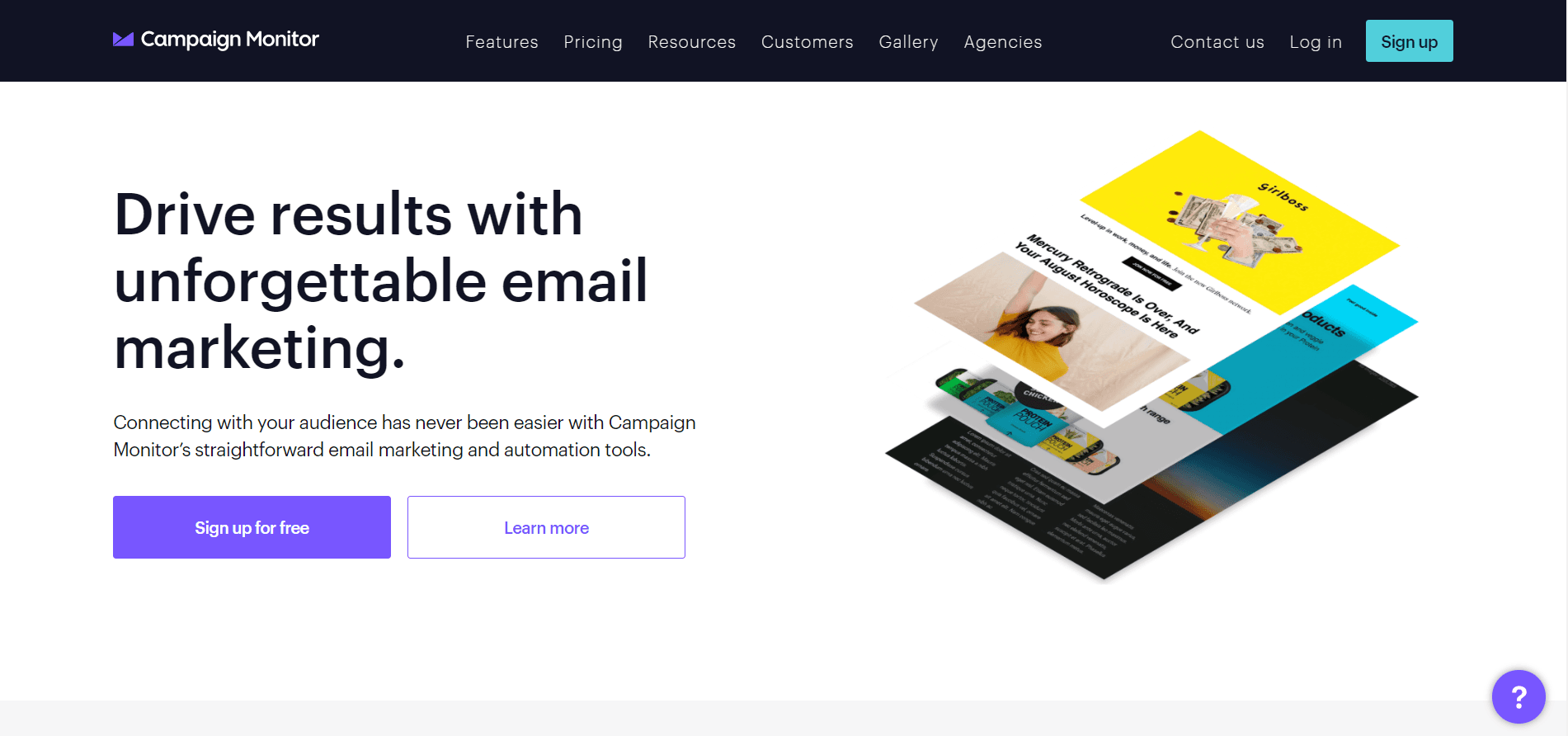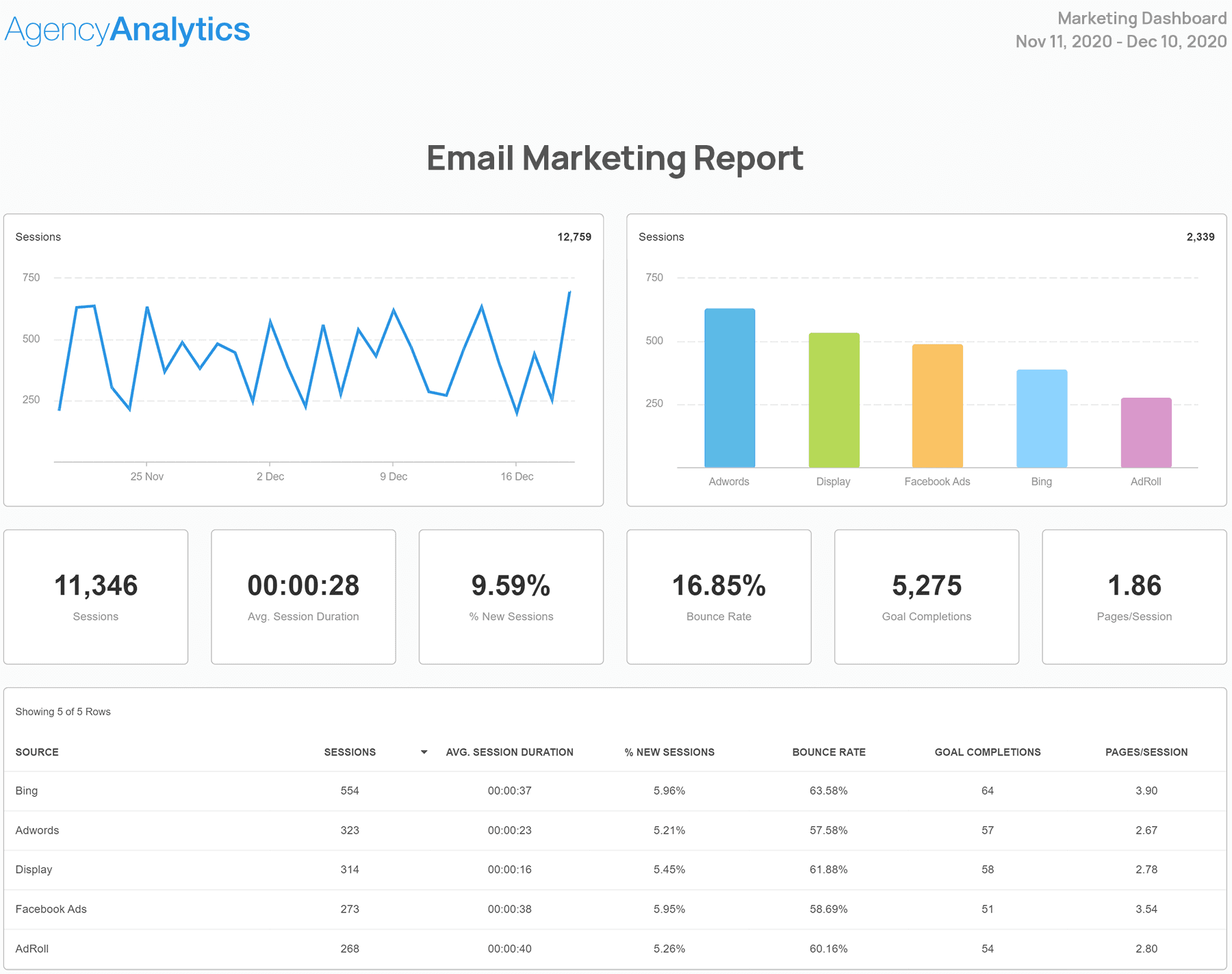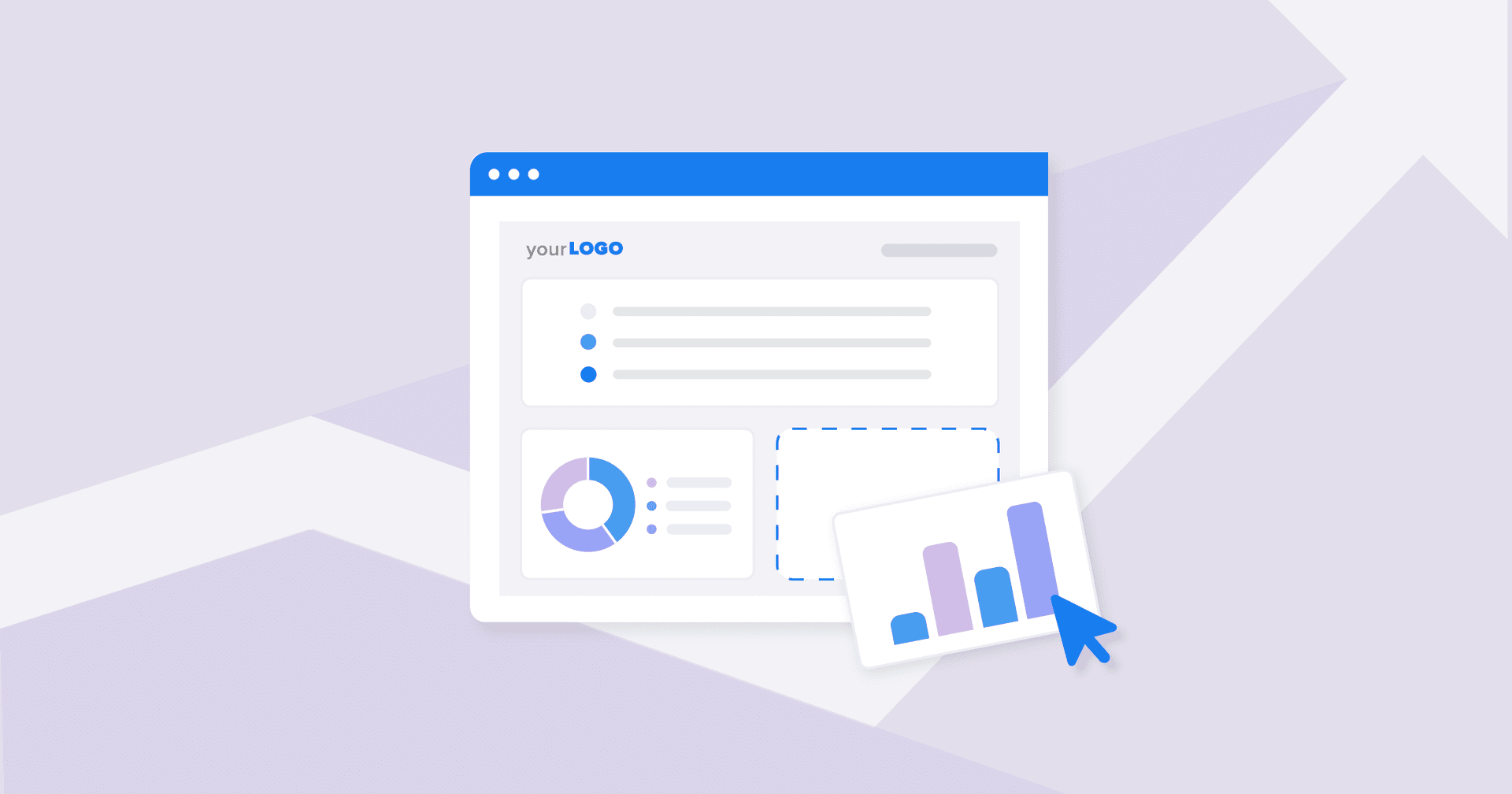Table of Contents
QUICK SUMMARY:
Campaign Monitor analytics provide insights into email campaign performance, helping agencies identify metrics that drive engagement, conversions, and ROI. This guide covers 18 key analytics, from open rates to mobile engagement, ensuring agencies deliver value-centered, results-driven reports that boost client confidence.
Marketers are busy. With an endless to-do list and the rush to deliver results, finding the right metrics to compile in a client report becomes a time-consuming challenge. It’s like putting together a complex puzzle where you’re expected to know exactly which pieces matter most for ROI, engagement, and conversions.
But with the right approach, Campaign Monitor offers a range of metrics that showcase campaign performance while helping you highlight the tangible value your agency brings to clients.
This article will walk you through the top 10 metrics within Campaign Monitor that go beyond basics, helping you focus on insights that matter. No more wondering which analytics to track. We’ve got you covered with the must-have metrics that will keep your campaigns optimized and your clients confident in your strategy.
What Is Campaign Monitor?

Campaign Monitor is an email marketing platform built with a focus on simplifying the creation, management, and tracking of email campaigns. Known for its straightforward design and powerful features, Campaign Monitor helps marketers deliver targeted messages that engage subscribers and drive measurable results.
Its interface offers a clean, user-friendly experience, which makes it accessible for users of varying skill levels, and its suite of tools supports the diverse needs of marketing agencies aiming to reach specific audience segments.
Campaign Monitor is a valuable platform for marketing agencies because it focuses on customization, automation, and data-driven insights. These features help agencies create successful campaigns that show clear value to their clients. With tools for growing email lists, segmenting audiences, testing, and tracking real-time results, agencies improve their email strategies and connect with audiences in more meaningful ways.
Top 18 Campaign Monitor Analytics to Track
Tracking the right analytics in Campaign Monitor gives agencies the data they need to refine their email strategies, boost engagement, and prove their value to clients. With insights into everything from open rates to spam complaints, these metrics reveal what’s working and what needs improvement.
Here’s an in-depth look at the key Campaign Monitor metrics that marketers should track in their client reports.
1. Bounced Emails
Bounced emails or email bounce rate indicate failed delivery attempts, which often harms sender reputation if left unaddressed. Monitoring bounced emails helps identify issues with email lists, such as outdated addresses, typos, or invalid accounts. Reducing bounce rates improves deliverability and ensures that more emails reach subscribers.
2. Click-Through Rate (CTR)
Click-through rate shows the percentage of subscribers who clicked on links within the email. This metric indicates how engaging and relevant the content is. Tracking CTR helps marketers assess what’s resonating with subscribers and refine their calls-to-action (CTAs) to drive desired actions.
3. Email Open Rate
Email open rate measures the percentage of subscribers who opened the email. This metric is a key indicator of subject line effectiveness and subscriber interest in the sender’s content. A healthy open rate shows that the emails are appealing and reaching the intended audience.
4. Email Click-to-Open Rate (CTOR)
Email click-to-open rate measures the percentage of unique clicks out of the unique opens, providing insight into how engaging the content was to those who actually opened the email. CTOR helps evaluate content effectiveness, showing which messages or CTAs are most compelling for engaged subscribers.
5. Total Clicks
Tracking total clicks gives a sense of overall engagement with the email. High click counts indicate strong interest, while low clicks might suggest that the content or offer isn’t compelling. Monitoring total clicks over time helps agencies refine their messaging and link placement.
6. Count
The count metric tracks the total number of emails sent in a campaign. This is helpful for understanding the overall reach and typically provides context for other metrics, such as open rate or CTR, by showing the scale of the campaign.
7. Forwards
Forwards or email forward rates show how often subscribers share the email with others, indicating strong interest and engagement. Emails with high forward rates may signal content that’s particularly valuable or relevant, providing insights into what subscribers find share-worthy.
8. Status
Status helps marketers keep track of the current state of each email (e.g., scheduled, sent, or draft). This simple metric ensures that agencies stay organized, and quickly confirms campaign progress for reporting or scheduling purposes.

Ditch the time-consuming process of pulling together email marketing data. This customizable email marketing report template does the heavy lifting for you. Try it out free for 14-days.
9. Lists
Lists or list growth rate refer to the subscriber groups that emails are sent to. Tracking which lists are receiving emails helps agencies target relevant content to different audience segments and ensure that campaigns reach the right subscribers.
10. Email Active
Email active metrics track how many subscribers are actively engaging with campaigns over a given period. Monitoring active subscribers helps marketers understand the current engagement level within a list and can guide decisions on list cleanups or re-engagement strategies.
11. Links
Tracking the performance of individual links in an email provides insight into what specific elements are engaging subscribers. Monitoring link clicks helps agencies identify which content or offers are driving the most interest and tailor future campaigns accordingly.
12. Mentions
Mentions track how often a specific product, service, or phrase is referenced within campaigns. Analyzing mentions helps gauge subscriber interest in certain topics, to guide content strategy and ensure emails stay relevant to subscriber interests.
13. Shares
Shares indicate when subscribers post the email content to social media or other platforms. High share rates suggest that the content has broad appeal and may increase brand visibility. Monitoring shares helps agencies understand which emails have the potential for wider reach.
14. Spam Complaints
Spam complaints measure the percentage of recipients marking the email as spam. High complaint rates may negatively impact the sender reputation, potentially causing future emails to end up in spam folders. Tracking this metric helps agencies monitor list quality and ensure email content aligns with subscriber expectations.
15. Email Subscribers
This metric tracks the total number of people on the email list. Monitoring email subscriber numbers over time helps gauge list growth or decline, which reflects the success of email strategies and overall audience interest.
16. Unique Opens
Unique opens count the number of individual subscribers who opened the email at least once. This metric helps marketers understand true engagement levels, as it doesn’t double-count subscribers who open the email multiple times.
17. Email Unsubscribe Rate
Email unsubscribe rate measures the percentage of subscribers who opted out of the list after receiving the email. This metric provides insight into how well the content resonates with the audience and guides adjustments in frequency, messaging, or targeting.
18. Recipients
Recipients indicate the total number of people who received the email. This count helps gauge the overall reach of a campaign and provides context for metrics like open rate, click-through rate, and conversion rate.
These Campaign Monitor metrics offer a detailed view of how email campaigns are performing. Regularly tracking these analytics helps agencies refine their approach, improve engagement, and deliver clear, measurable results to their clients.
Turning Raw Campaign Monitor Analytics Data Into Actionable Insights
Providing clients with a straightforward breakdown of Campaign Monitor analytics is just the first step.
While metrics like open rates, bounces, and click-through rates are helpful, turning these raw numbers into actionable insights is what truly drives value. Clients rely on agencies to report on performance and also translate data into strategic recommendations that align with their company goals.
By moving beyond the basics and offering meaningful marketing campaign analysis, marketers create actionable strategies that help clients increase sales, connect with targeted segments, and improve the success of automated emails.
Here are some tips for turning Campaign Monitor analytics into insights that lead to results:
Set Clear Goals & KPIs: Establish specific goals and KPIs to measure progress and ensure that each campaign aligns with the client’s business objectives.
Identify Key Metrics: Focus on the metrics that matter most, such as email clients, bounces, and segment engagement, to provide clear value.
Analyze Trends: Look for patterns over time to understand which campaigns resonate with subscribers and adjust future emails accordingly.
Benchmark Against Competitors: Compare performance metrics with industry benchmarks to evaluate how the client’s campaigns stack up and find areas for improvement.
Connect the Dots With Other Platforms: Link email data with website analytics and social media insights to create a fuller picture of campaign impact across platforms.
Use Insights To Drive Strategy: Use findings to shape content, timing, and segmentation, ensuring campaigns are created with data-backed strategies.
Agencies develop data-informed strategies that drive meaningful results by setting realistic marketing goals, identifying relevant metrics, analyzing trends, and benchmarking against competitors. When insights from Campaign Monitor are integrated with other marketing platforms, clients see the full impact of their campaigns and make informed decisions that align with their long-term goals.
How To Create Campaign Monitor Analytics Reports Using AgencyAnalytics
Creating Campaign Monitor analytics reports in AgencyAnalytics helps agencies monitor key email metrics all in one place. This centralized approach saves time and offers a clear view of campaign performance, making it easier to track metrics like open rates, clicks, and subscriber growth.
With customizable dashboards and real-time updates, marketers link other platforms like Google Ads, Instagram, Hubspot, and Shopify to get a complete view of a client’s marketing data.
Start by logging into your AgencyAnalytics account and navigating to the client account for which you’d like to build a Campaign Monitor analytics dashboard. Then, select “add” in the drop-down menu to create a new dashboard.

Next, you’ll be prompted to choose how you’d like to create the insights dashboard:

We’ve chosen to create a blank dashboard for this example. This allows you to drag and drop specific widgets you’d like from a variety of marketing platforms.

Having the ability to share access to the live dashboards with clients allows them to dive deeper into the analytics without needing us to dig up specific metrics on their behalf. This has reduced the number of requests/calls we receive from clients throughout the month.
Bryan Lozano, Vice President of Operations, Ad-Apt
Under a time crunch? The Smart Reports and Smart Dashboards feature from AgencyAnalytics builds exactly what you need in 11 seconds or less. Try it out for yourself with a 14-day free trial.
With access to over 80 marketing channels, AgencyAnalytics gives agencies a complete picture of a client's marketing activity in one place. The platform’s user-friendly interface makes it easy to visualize data, identify trends, and make informed decisions, all while keeping clients in the loop with real-time insights.

Highlight the most important aspects of your clients’ email performance in an easy-to-read report using Ask AI. This feature summarizes important findings and showcases your agency’s value front and center. Try it out with your 14-day free trial of AgencyAnalytics.
5 Tips for Creating Campaign Monitor Reports That Wow Clients
Creating Campaign Monitor reports that truly impress clients goes beyond just presenting data. Effective reports should tell a clear story, focus on results that matter, and demonstrate the unique value your agency brings. By combining Campaign Monitor insights with other key metrics, using automated tools, and branding reports with your agency’s style, you keep clients informed and engaged. Here are five tips to create client-ready reports that stand out.
1. Combine Campaign Monitor with All of Your Clients’ Other Campaign Metrics Integrate Campaign Monitor data with other essential metrics from platforms like Google Analytics 4, Google Ads, Facebook, and SEO rankings. This gives clients a complete view of their marketing performance across channels, helping them see how email campaigns fit into the broader strategy. Combined reporting shows the impact of email campaigns in context and highlights how link tracking, account type, and mobile device engagement compare to other efforts.
2. Track the Right Campaign Monitor Metrics Focus on tracking metrics that align with the client’s goals, such as open rates, bounce rates, link clicks, and subscriber growth. Tailoring metrics ensures clients receive data that speaks to their specific objectives rather than overwhelming them with unnecessary numbers. Tracking the right data shows clients that you’re focused on results that move the needle.
3. Focus on the Results That Matter Emphasize key outcomes like conversions, list growth, and email engagement rather than just click counts or opens. Highlighting tangible results, like how many subscribers a campaign gained or how link tracking contributed to conversions, demonstrates the effectiveness of each email campaign. Clear results make it easy for clients to understand the impact of your work.
4. Use Automated Reporting Tools Leverage automated reporting tools to keep clients updated on their email performance without extra manual work. Tools like AgencyAnalytics streamline reporting, allowing you to set up regular, professional reports that clients can review at their convenience. Automation frees up time for your team to focus on strategy and ensures clients always have access to the latest insights.
5. Wrap Results in Your Agency’s Brand Presenting reports with your agency’s branding adds a professional, cohesive touch. Customize report templates with your agency’s logo, colors, and styling so that every report feels consistent and on-brand. Branded reports enhance client trust and position your agency as an expert resource, reinforcing your role as a valued partner.
Summary and Key Takeaways
To create Campaign Monitor reports that are impactful and client-focused, here are the key action steps for agencies:
Evaluate Your Current Campaign Monitor Analytics Approach: Review how you’re tracking and presenting Campaign Monitor metrics, like open rates and spam testing results, to ensure they align with each client’s goals.
Explore Third-Party Tools: Consider tools like AgencyAnalytics to enhance campaign tracking and reporting. Look for features that fit your agency’s needs, like integration with mobile devices, Google Analytics, and CSV file exports.
Customize Reports for Client Needs: Personalize Campaign Monitor analytics reports to align with each client's objectives and preferences. Add your agency’s branding and highlight metrics that matter most, from the visual journey designer to list growth.
Set Up Automated Reporting: Configure automated reports to keep clients updated on campaign performance without requiring manual work. This setup ensures clients stay informed about metrics like CTR and mobile engagement.
By refining your approach to Campaign Monitor reporting, you’ll provide clients with valuable insights, simplify campaign tracking, and showcase the unique strengths of your agency.
Need help linking a client’s Campaign Monitor account? Check out our help article here.

Written by
Richelle Peace is a writer with a degree in Journalism who focuses on web content, blog posts, and social media. She enjoys learning about different topics and sharing that knowledge with others. When she isn’t writing, Richelle spends time teaching yoga, where she combines mindfulness, movement, and her passion for wellness.
Read more posts by Richelle PeaceSee how 7,000+ marketing agencies help clients win
Free 14-day trial. No credit card required.






